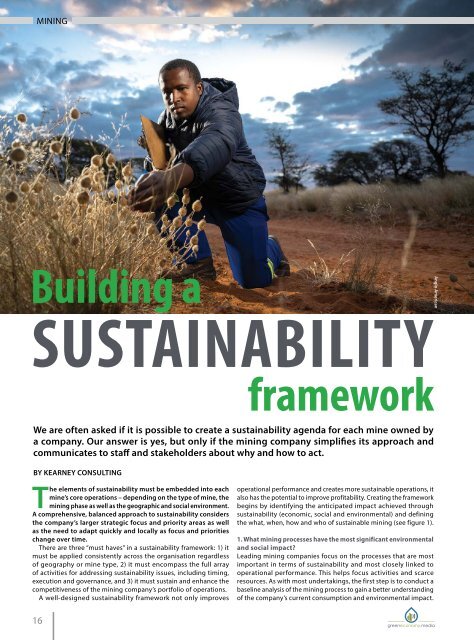Green Economy Journal Issue 62
You also want an ePaper? Increase the reach of your titles
YUMPU automatically turns print PDFs into web optimized ePapers that Google loves.
MINING<br />
MINING<br />
Anglo American<br />
Sustainability must<br />
become a part of the<br />
day-to-day job.<br />
Building a<br />
SUSTAINABILITY<br />
We are often asked if it is possible to create a sustainability agenda for each mine owned by<br />
a company. Our answer is yes, but only if the mining company simplifies its approach and<br />
communicates to staff and stakeholders about why and how to act.<br />
BY KEARNEY CONSULTING<br />
The elements of sustainability must be embedded into each<br />
mine’s core operations – depending on the type of mine, the<br />
mining phase as well as the geographic and social environment.<br />
A comprehensive, balanced approach to sustainability considers<br />
the company’s larger strategic focus and priority areas as well<br />
as the need to adapt quickly and locally as focus and priorities<br />
change over time.<br />
There are three “must haves” in a sustainability framework: 1) it<br />
must be applied consistently across the organisation regardless<br />
of geography or mine type, 2) it must encompass the full array<br />
of activities for addressing sustainability issues, including timing,<br />
execution and governance, and 3) it must sustain and enhance the<br />
competitiveness of the mining company’s portfolio of operations.<br />
A well-designed sustainability framework not only improves<br />
framework<br />
operational performance and creates more sustainable operations, it<br />
also has the potential to improve profitability. Creating the framework<br />
begins by identifying the anticipated impact achieved through<br />
sustainability (economic, social and environmental) and defining<br />
the what, when, how and who of sustainable mining (see figure 1).<br />
1. What mining processes have the most significant environmental<br />
and social impact?<br />
Leading mining companies focus on the processes that are most<br />
important in terms of sustainability and most closely linked to<br />
operational performance. This helps focus activities and scarce<br />
resources. As with most undertakings, the first step is to conduct a<br />
baseline analysis of the mining process to gain a better understanding<br />
of the company’s current consumption and environmental impact.<br />
Anglo American<br />
Kearney Analysis<br />
Framework for sustainable mining<br />
Figure 1. The “what, who, when and how” of sustainability in mining.<br />
A good analysis assesses existing regulations, operations, energy<br />
mix, social impact and sustainability practices. It is important to<br />
assess performance at all mining phases – exploration, operations,<br />
closure and post-closure – and within all subcategories (see figure<br />
2). The grey shaded areas in figure 2 highlight where a mine’s impact<br />
is most significant. The subcategories are then adapted depending<br />
on the specific environmental circumstances of the area.<br />
Energy-related pollution is easy to assess using metering tools to<br />
gauge the local energy mix, but analysing a mine’s social impact is<br />
often more difficult as it relies on people filling out questionnaires,<br />
Exploration Operations Closure Post-closure<br />
Figure 2. The impact of processes and activities across mining operations.<br />
Above: Berm monitoring at Kumba Iron Ore’s Kolomela mine.<br />
Main picture: Tamaga Lodge is one of three biodiversity conservation areas<br />
on the western side of Sishen mine. These areas were originally livestock<br />
farms and are being carefully restored to their natural state.<br />
Celebrate and communicate<br />
the small quick wins.<br />
which are based on subjective opinions. We recommend going a<br />
step further and using tools to determine areas most important for<br />
a region and individual mines.<br />
2. When – at what phase in the mining process – do sustainability<br />
initiatives have the biggest impact on a mine’s life cycle?<br />
The earlier a strategy and game plan are defined; the more likely<br />
sustainability (linked to operational performance) will be successfully<br />
integrated into all aspects of planning and operations. In this way, a<br />
negative impact within a mining phase can be mitigated. For example,<br />
figure 3 illustrates an impact assessment on water, evaluating acidity,<br />
heavy metals, chemical processing, sedimentation and quantities at<br />
all four phases. Two potential mitigation points are highlighted in<br />
the operations phase and at post-closure.<br />
The most significant steps are taken when a mine is in the initial<br />
stages of design, when it is still possible to mitigate a potential<br />
negative impact before it happens, and when relatively simple<br />
measures can drive sustainable operations, improve operational<br />
opportunities and cut costs (see figure 4). Measures implemented<br />
at a later phase will be far more costly.<br />
3. How does a mining company avoid a negative social or<br />
environmental impact?<br />
A select set of priority initiatives is available to identify and address<br />
negative social or environmental impacts across the various mining<br />
phases. We use the following hierarchy to assess a potential impact<br />
(see figure 5):<br />
• Avoid an unacceptable impact by considering a different<br />
project location, sitting, scale, layout, technology or phase or<br />
ultimately by cancelling development<br />
• Minimise a largely unacceptable impact by considering the<br />
same options used to avoid an impact<br />
16 17

















